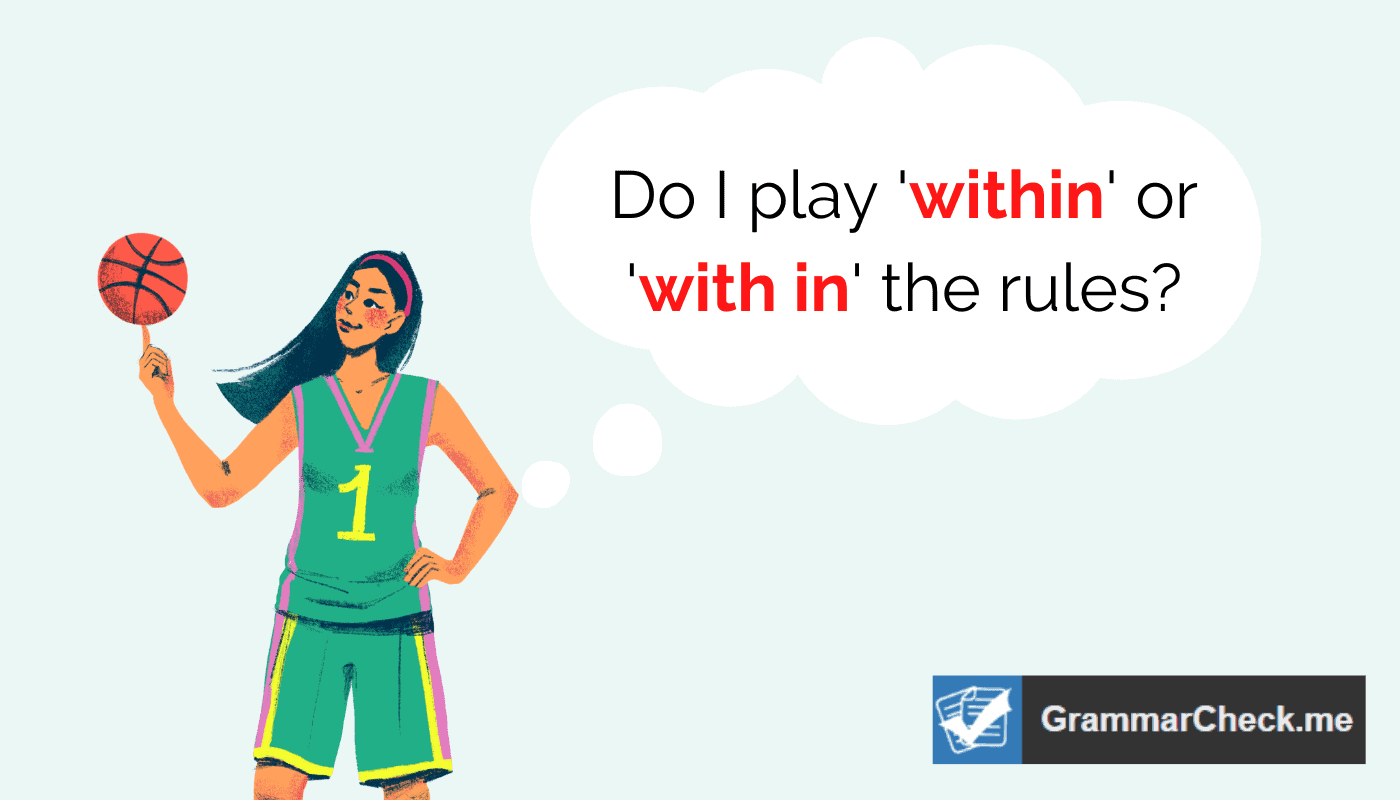Many writers get tripped up when it comes to the spelling of ‘within’ or ‘with in’. In fact, this reminds me of the words goodnight and good night, which most writers spell incorrectly. Small spelling differences can make a huge difference in the meaning of words and phrases. In this post, we’ll teach you exactly how to choose between ‘within vs ‘with in’ in your writing!
Which Is Correct: Within or With In

The words ‘within’ vs ‘with in’ remind me a lot of the spelling of how ever vs however. In fact, the words within and without pretty much have the same definition! If you are trying to convey that something is inside, you should example the parts of speech & consider these grammar rules:
- Within: The word “within” is a preposition that means inside. For example, you might say “I’m Within the house” or “the cat is within the box.” When used in this way, it’s basically a fancy way of saying “inside.” But the word “within” can also be used to denote a more abstract concept of being contained or limited.
- With In: “With” & “in” are both real words. “With” is a preposition. “In” is a noun, preposition, adjective or adverb. However, it is NOT grammatically correct to say “with in” to mean inside.
Takeaway: Adding a space between words, like with Upto vs up to, completely changes the meaning of a word. Do not use a space when writing the words within or without. It is correct grammar to form a single word.
Sentence Examples
- I’m only going to stay within the confines of this room.
- I need to stay within budget this month.
- He was within an inch of winning the game.
- We need to get this project done within the next week.
- The meeting will start within the hour.
- I can’t believe she was able to fit all of that within her tiny purse!
- They need to be more careful with their words, or they’ll get themselves into trouble within the community.
Just like we saw in our analysis of the phrase “safe travels” even a small spelling change can modify the meaning of the word or sentence.
Prepositions 101
I think we have all heard of prepositions like to or too bad. Prepositions are those pesky little words that we use all the time, but often don’t really think about. They’re the word or group of words that come before the following things:
- Noun
- Pronoun
- Noun phrase
Prepositions are used to show direction, time, place, location, spatial relationships, or to introduce an object. Here are some example sentences using prepositions.
- I’m afraid of heights, so I’ll stay below you on the ladder.
- Please pass the remote control under the couch cushions.
- Between you and me, I think our boss is a total idiot.
What About: In vs Within?
‘In’ and ‘within’ are both prepositions that describe location.
‘In’ is used when there is a specific time or a definite location.
- For example, ‘in the morning,’ ‘in 2005,’ ‘in New York.’
‘Within’ is used when there is not a specific time or place. Used to indicate that something or someone is inside boundaries. If you can’t master when to use within, use our spelling checker tool to make it easy!
- For example, ‘within these pages,’ ‘within reach,’ ‘within five minutes.’
When in doubt, you can usually replace ‘within’ with ‘in’ without changing the meaning of the sentence. So, next time you’re trying to decide which preposition to use, ask yourself if you can be more specific. If so, reach for ‘in.’ If not, ‘within’ is probably your best bet. This actually follows the same grammar rules as incase or in case!
Within vs Inside: Is There A Difference?
‘Inside’ and ‘within’ are two words that are often used interchangeably, just like in regard or in regards, but there is actually a subtle difference between them. ‘Inside’ is typically used to describe position or location, while ‘within’ is more often used to describe time or space.
Frequently Asked Questions
We use “within” when we’re referring to a specific time or space. For example, “I’ll be there within ten minutes.” This means that you’ll arrive in less than ten minutes.
If you wanted to use ‘within’ in a sentence you might say, “I am going to play within the rules of the game.”
The phrase “within 30 days” means that something will happen over a 30-day period.
The phrase “within 30 days” means that something will happen over a 2 week period.
“With” is a preposition. It always comes before the noun it modifies. For example, in the sentence “He is with his friends,” with is a preposition and modifies the noun friends.
The Bottom Line
We hope this article has helped you understand the proper use of “within” and “with in”. Now you know that slight spelling difference, like the words gooses or geese, makes a big difference. Remember, if you are ever unsure about which word to use, consult a trusted grammar resource like the quillbot grammar checker or contact us for help.
